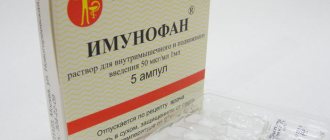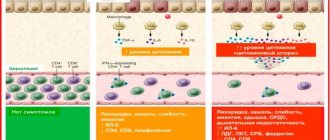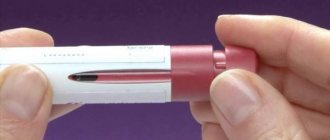Clinical and pharmacological group
The original drug, which belongs to the safe group of cholinesterase inhibitors, effectively restores and stimulates the impulses of the central nervous system and the central nervous system. The drug, occupying one of the leading places in therapy, has pharmacological effects such as:
- increases the level of vital activity of smooth muscles;
- increases the ability to remember and gently stimulates central nervous system processes;
- restores brain activity;
- inhibits the development of dementia.
The drug, based on a combination of two mechanisms of action, provides positive treatment, exhibiting analgesic, sedative, and antiarrhythmic effects. When treated with the drug, the health status improves, the function of the patient’s peripheral nerves and central nervous system after suffering various diseases and injuries is gradually restored.
Side effects of Neuromidin
Reviews of Neuromidin indicate that taking the drug can provoke the occurrence of: bradycardia, jaundice, increased sweating and bronchial secretion, salivation, diarrhea, palpitations, convulsions, nausea, epigastric pain.
When used in high doses, according to reviews, Neuromidin causes: dizziness, general weakness, headache, vomiting, drowsiness, allergic skin reactions. In such cases, it is recommended to stop taking the drug for several days or reduce the dose.
It is also necessary to take into account that alcohol increases the side effects caused by the use of Neuromidin.
Release form, composition and packaging of the medicine
The active biological component of the drug is ipidacrine. White tablets are in blister packs of 10 pieces and 5 contour cells in a cardboard box. One tablet contains 20 mg of ipidacrine, which includes additional components: potato starch, calcium stearate, glucose, monohydrate.
The medicine in the form of a solution is presented in ampoules made of neutral glass, which are placed in blister packaging made of polyvinyl chloride film, 10 pieces in a cardboard box. One ampoule of solution contains 5 mg ipidacrine. Excipients: hydrochloric acid, water for injection.
Contraindications
Neuromidin is not prescribed for: extrapyramidal diseases with hyperkinesis, obstruction of the urinary tract and intestines, angina pectoris, epilepsy, severe bradycardia, individual intolerance to the components of the drug, bronchial asthma. The drug is also prohibited for patients prone to vestibular disorders. Neuromidin is contraindicated in children under the age of eighteen and women: pregnant and lactating.
Neuromidin is used with caution: for acute diseases of the respiratory tract, thyrotoxicosis, diseases of the heart and blood vessels, peptic ulcer of the duodenum and stomach. If necessary, the drug is replaced with Neuromidin analogues.
Dosage
Doses and duration of therapy depend on the severity of the disease and are prescribed by the doctor individually. The treatment summary is presented by the manufacturer in the instruction leaflet approved by the Ministry of Health. Treatment with the drug in the form of a solution can last from 1 to 2 months. Injections are administered intramuscularly or subcutaneously 1-2 times a day. (see how to properly give intramuscular injections yourself)
For myasthenic crises, bulbar palsy and cuts, memory disorders of various origins, treatment is continued with tablets, increasing the dose by 1-2 tablets 5-6 times a day. The course of treatment is shortened. Depending on the form of the disease, the duration of treatment ranges from 1 month to a year.
Neuromidin, 5 mg/ml, solution for intramuscular and subcutaneous administration, 1 ml, 10 pcs.
Approved by the Pharmacological Committee of the Russian Ministry of Health
INSTRUCTIONS (information for the patient) for the use of the drug NEIROMIDINUM
International nonproprietary name
Ipidacrine (9-Amino-2,3,5,6,7,8-hexahydro-1H-cyclopenta(b)quinoline hydrochloride monohydrate).
Dosage form
Pills.
Compound
Ipidacrine 20 mg.
Excipients: lactose, potato starch, calcium stearate.
Description
White tablets. In appearance they must comply with the requirements of the Global Fund XI, issue 2, p. 154.
Diameter - 6.0±0.2 mm.
Height - 2.7±0.3 mm.
Pharmacotherapeutic group
Cholinesterase inhibitor, neuromuscular conduction stimulator/ATS - N07AAOO.
Pharmacological properties
Neuromidin is a reversible cholinesterase inhibitor and also has a direct stimulating effect on impulse conduction at the neuromuscular synapse and in the central nervous system due to blockade of potassium channels in the excitable membrane.
Neuromidin enhances the effect on smooth muscles of not only acetylcholine, but also adrenaline, serotonin, histamine and oxytocin.
Neuromidin has the following pharmacological effects:
— restores and stimulates neuromuscular transmission;
- restores the conduction of impulses in the peripheral nervous system, disturbed due to the influence of various factors (trauma, inflammation, exposure to local anesthetics, some antibiotics, potassium chloride and other factors);
- enhances the contractility of smooth muscle organs under the influence of all agonists, with the exception of potassium chloride;
- moderately stimulates the central nervous system;
- improves memory and learning.
The drug does not have teratogenic, embryotoxic, mutagenic and carcinogenic, as well as allergenic or immunotoxic effects. The drug does not have a negative effect on the endocrine system.
After oral administration, Neuromidin is rapidly absorbed. The maximum concentration in the blood is observed after one hour. From the blood, Neuromidin quickly enters the tissues, and in the stabilization stage only 2% of the drug is found in the blood serum. Elimination of Neuromidin occurs through the kidneys, as well as extrarenally (biotransformation, secretion in bile). Only 3.7% of Neuromidin is excreted unchanged. This indicates the rapid metabolism of Neuromidin in the body.
Indications for use
Neuromidin is used in adults for diseases of the peripheral nervous system (neuritis, polyneuritis and polyneuropathy, polyradiculoneuropathies, myasthenia gravis and various myasthenic syndromes); bulbar paralysis and paresis, in the recovery period with organic lesions of the central nervous system, accompanied by motor disorders; in complex therapy of demyelinating diseases, with intestinal atony.
Contraindications
The use of Neuromidin is contraindicated in cases of epilepsy, extrapyramidal diseases, angina pectoris, severe bradycardia, bronchial asthma, individual hypersensitivity to the drug, vestibular disorders, peptic ulcer in the acute stage.
Use of the drug during pregnancy and lactation
Neuromidin penetrates well into all tissues of the body, increases the tone of the uterus and can cause premature birth, so it is not recommended to use the drug during pregnancy. The drug is used for weak labor. Contraindicated during breastfeeding.
Directions for use and doses
Neuromidin is used orally 1-3 times a day. A single dose of the drug is 10–20 mg (0.01–0.02 g) (0.5–1 tablets). For lesions of the peripheral nervous system, myasthenia gravis and myasthenic syndromes, the drug is prescribed orally at 10–20 mg (0.01–0.02 g) 1–3 times a day for 1–2 months. For short-term courses of treatment of patients with severe disorders of neuromuscular transmission, a single dose can be 20–40 mg (0.02–0.04 g) orally (1–2 tablets) 5–6 times a day.
For the treatment and prevention of intestinal atony, 20 mg (0.02 g) is prescribed 2-3 times a day for 1-2 weeks. If the next dose has not been taken, then continue the course of treatment at the previously prescribed doses. If necessary, you should consult your doctor.
special instructions
The drug increases the muscle tone of the uterus and can cause premature labor. Prescribe with caution for gastric ulcers, thyrotoxicosis, and diseases of the cardiovascular system.
Neuromidin penetrates well into tissues and organs, including the brain, and can have a sedative effect. Therefore, persons using Neuromidin should be careful when working with machinery. During treatment you should not drink alcohol.
Drug interactions
The drug enhances the sedative effect when interacting with central nervous system depressants. The action and side effects are enhanced when used together with other cholinesterase inhibitors and m-cholinomimetic drugs. In patients with myasthenia gravis, the risk of cholinergic crisis increases if Neuromidin is used simultaneously with other cholinergic drugs. Beta-blockers cause bradycardia if they were used before treatment with Neuromidin. When used simultaneously with alcohol, adverse side effects may increase.
Overdose
In case of Neuromidin poisoning or its relative overdose, m-anticholinergic blockers are used: atropine, cyclodol, etc.
Side effects
When using Neuromidin, hypersalivation, bradycardia, dizziness, nausea, vomiting, and allergic skin reactions (itching, rash) are possible. In these cases, reduce the dose or discontinue the drug. Hypersalivation and bradycardia can be reduced with m-anticholinergic blockers.
If during treatment with Neuromidin side effects are discovered that are not listed in the instructions, then it is necessary to inform the attending physician.
Manufacturer
JSC Olainsky Chemical-Pharmaceutical.
Address: st. Rupnicu 5, Olaine, LV-2114, Latvia.
How does Neuromidin work?
The active substance Neuromidin was developed in the late 80s and replaced Prozerin, which had been used in neurology for many years. Unlike a conventional inhibitor, Ipidacrine simultaneously combines several mechanisms of action and is capable of stimulating structural formations of the central nervous system, which significantly expands the range of indications for its use. In modern medical practice, both drugs are used, and they are often compared.
Only the attending physician can determine whether Neuromidin or Proserin is better, separately for each specific patient and clinical case.
It has been established that the chemical structure of Proserin makes it difficult for its molecules to penetrate biological membranes, so the drug mainly affects only cholinergic (transmitting excitation using acetylcholine) peripheral synapses located on the border between nerve endings and working organs.
- The therapeutic effect of Proserin is more pronounced and appears within 10-15 minutes after administration, but ends after 2-3 hours.
- The effect of Neuromidin is felt after 15-20 minutes and lasts for 3-5 hours. In addition, Ipidacrine affects all parts of the distribution of excitation, which additionally determines its analgesic and sedative properties, and antiarrhythmic effect.
How Neuromidin acts on the body and what it helps with:
- changes the excitability of the cell, provides the ability to adequately respond to a stimulus;
- normalizes the transmission of nerve impulses and their transformation into mechanical movement, improves the ability of muscle tissue to express contractions;
- enhances the effect of mediator substances on nerve ganglia, smooth and striated muscles;
- stimulates the autonomic nervous system, maintaining homeostasis;
- increases muscle tone, strength in the affected muscles, prevents the occurrence of attacks, reduces the severity of paralysis, paresis, sensitivity disorders in the innervation zone;
- improves concentration, prevents memory loss, decreased cognitive function, behavioral disorders and other signs of dementia.
Information about: anti-inflammatory drug Diaflex may be useful.
The instructions provide the main pharmacokinetic parameters of Neuromidin:
- Absorption: when taken orally or parenterally, the active substance is quickly absorbed, the peak concentration in the blood is recorded after 1 hour (from the gastrointestinal tract) and 25-30 minutes (from the injection site), respectively.
- Distribution: in the systemic circulation, Ipidacrine circulates half in free form, 40-50% of the incoming dose is bound to plasma proteins. 50% equilibrium concentration in target tissues is achieved after 40 minutes.
- Metabolism: under the influence of liver enzymes, the substance is partially biotransformed.
- Excretion: leaves the body in the urine and through extrarenal excretory organs. The concentration of Ipidacrine in the bloodstream decreases by 50% 2-3 hours after the injection.
special instructions
During therapy, it is necessary to avoid drinking drinks containing ethyl alcohol, due to the increased effects of ipidacrine under the influence of alcohol.
Also, the medication has a pronounced effect on concentration and spatial orientation, which is the reason for refraining from driving vehicles and working with high-precision mechanisms during the period of preventive and medicinal use of Neuromidin.
Drug interactions
When Neuromidin is used simultaneously with certain drugs, the following effects may develop:
- Central nervous system depressants: increased sedative effect;
- Other cholinesterase inhibitors and m-cholinomimetic agents: increased action and side effects of Neuromidin;
- Other cholinergic drugs (in patients with myasthenia gravis): increased risk of developing a cholinergic crisis;
- Beta-blockers (when used before starting Neuromidin therapy): increased risk of bradycardia;
- Local anesthetics, aminoglycosides, potassium chloride: weakening the inhibitory effect on neuromuscular transmission and conduction of excitation along peripheral nerves;
- Ethanol: increased side effects of Neuromidin.
Overdose of the drug Neuromidin, symptoms and treatment
In case of severe overdose, a cholinergic crisis may develop with the following symptoms: bronchospasm, lacrimation, increased sweating, miosis, nystagmus, spontaneous defecation and urination, vomiting, bradycardia, heart block, arrhythmia, arterial hypotension, restlessness, anxiety, agitation, a feeling of fear, ataxia, convulsions, coma, slurred speech, drowsiness and weakness. Symptoms may be mild. In case of Neuromidin poisoning or its relative overdose, M-anticholinergic blockers (atropine sulfate, metacin, cyclodol, etc.) are used.
Signs of overdose
Exceeding the dose, which is usually observed with uncontrolled medication use, reveals itself with the following symptoms:
- heavy sweating;
- constriction of the pupils;
- spasms in the bronchi;
- nausea and vomiting;
- lacrimation;
- spasms of the muscles of internal organs;
- jaundice;
- cardiac dysfunction src=”https://tyubik.net/uploads/posts/2017-10/1508947709_kakie-priznaki-peredozirovki-mogut-byt.jpg” class=”aligncenter” width=”500″ height=”344″[ /img]
- decreased blood pressure;
- weakness;
- constant desire to sleep;
- partial urination;
- an excited state, during which unreasonable fear and anxiety appear;
- convulsions;
- speech disorders.
To eliminate the result of an overdose, the specialist uses Atropine, Metacin and other m-anticholinergic drugs. Medicines are also used to treat symptoms.
Pharmacological properties of the drug
The Anatomical-Therapeutic-Chemical Classifier classifies Neuromidin as a psychoanaleptic - drugs that have a stimulating effect on the nervous system and activate mental activity, restoring it from a state of oppression after blockade by various agents. Such a negative factor may be an injury, the use of bactericidal, local anesthetics, damage to synapses due to the inflammatory process, hypoxia, the influence of bacterial toxins or nerve poisons. Neuromidin is a representative of the class of cholinesterase inhibitors, otherwise an anticholinesterase agent.
The pharmacological properties of the drug are due to the presence of Ipidacrine in its composition, which is characterized by the ability to:
- block the permeability of cell membranes to potassium ions, prolonging the repolarization phase (the time required to restore the original resting potential of the membrane and its readiness to accept a new signal);
- increase the activity of the process of presynaptic neurons, which transmits a signal to excitable cells - muscle fibers that contract in response, or through a chain of other nerve cells that conduct and transform impulses in the nervous system;
- enhance the release from synaptic vesicles and accumulation in the intercellular space of transmitters of nervous excitation (various neurotransmitters, primarily acetylcholine, as well as serotonin, histamine, the hormone adrenaline, the neuropeptide oxytocin), which interact with special receptors localized on the outer side of the membrane of the postsynaptic cell, causing excitation or inhibition of the activity of a postsynaptic neuron;
- inhibit the activity of acetylcholinesterase (a hydrolytic enzyme from the esterase family contained in synapses), preventing the breakdown and rapid destruction of the most important CNS mediator acetylcholine.
Analogs
Instead of Neuromidin, the following medications can be used:
- Aksamon is a complete analogue of Neuromidin. It is produced in tablets and injections, which are given subcutaneously or intramuscularly. Axamon should not be taken by children or nursing mothers; during pregnancy it can cause premature birth.
- Ipigrix is a complete analogue of Neuromidin. It is sold as an injection solution and tablets. They are contraindicated for persons under 18 years of age, pregnant women and those supporting breastfeeding.
- Prozerin is a domestic drug produced by several Russian companies in tablets and injections. It is a substitute for Neuromidin. The drug can be used in children; it is used to stimulate labor.
- Amiridin is a substitute for the drug Neuromidin in the clinical and pharmacological group. Medicines are produced in injections and tablets. They should not be taken during pregnancy and breastfeeding.
Indications for use of the drug Neuromidin
Lesions of the peripheral nervous system - neuropathy, neuritis, polyneuritis, polyneuropathy, myelopolyradiculoneuritis, bulbar palsy and paresis; memory impairments of various origins (Alzheimer's disease and other forms of dementia in the elderly), mental retardation in children; lesions of the central nervous system of traumatic, vascular and other origins with impairments of memory, praxis, attention; myasthenia gravis and myasthenic syndromes; complex therapy of multiple sclerosis and other forms of demyelinating diseases of the nervous system; weakness of labor; intestinal atony.
Instructions for use
The Neuromidin treatment system depends on the patient’s well-being and pathology.
The doctor determines how to use the drug - orally, subcutaneously or intravenously.
Neuromidin is a potent medicine and is only available with a prescription.
For lesions of the nervous system of any etiology, therapy takes place in several stages:
- It begins with injection under the skin or into a vein. The dosage depends on the specific disease: for neuropathy and paralysis - 5-15 mg twice a day for 10 to 15 days, for myasthenia gravis - 15-30 mg twice or thrice for 1-2 months and repeat after a month's rest.
- After a course of injections, a transition to the tablet form is made.
When using, it is worth considering compatibility with other medications. The pharmacological effect of Neuromidin is enhanced by simultaneous treatment with other inhibitors and alcohol. Combinations with nootropic medications are possible.




